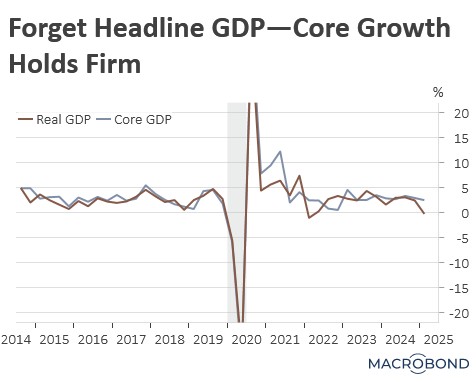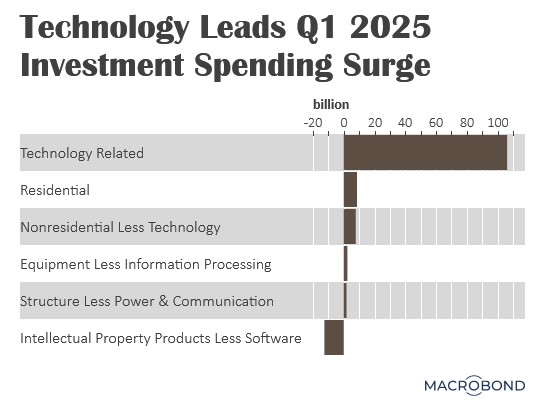Tag: AI
Asset Allocation Bi-Weekly – The Economy That Won’t Die (June 16, 2025)
by Thomas Wash | PDF
The old Wall Street quip about economists having “predicted nine of the last five recessions” has never felt more painfully relevant. Since the pandemic era began, economists have sounded the recession alarm no fewer than three times: first when gross domestic product (GDP) shrank in early 2022, again during the Silicon Valley Bank crisis of 2023, and most recently when the Sahm Rule was triggered during the summer of 2024. Yet America’s economic engine keeps chugging along, leaving analysts scrambling to explain why the doom forecasts keep missing their mark.
The stock market’s reaction to President Trump’s tariff announcement followed this now-familiar pattern of panic and resilience. Initial headlines sparked a sell-off that briefly dragged the S&P 500 stock price index below 5,000 for the first time in months. But within weeks, the index came roaring back, erasing its year-to-date losses and flirting with bull market territory. This whipsaw action revealed an important truth: Investors are increasingly betting that the economy can absorb policy shocks that would have crippled previous expansions.
This underlying economic resilience, even in the face of apparent warning flags, highlights the importance of looking beyond superficial data. The solution may lie in what analysts call “core GDP,” which measures the final sales to private domestic purchasers. Where the headline GDP figure mixes volatile government spending and trade data with underlying demand, this refined metric instead focuses solely on how much US households and businesses are actually buying. This distinction proved critical in understanding the first quarter’s apparent contraction, which upon closer examination revealed more about temporary distortions than fundamental weakness.
In the first quarter, a surge in imports caused by companies racing to beat the coming tariffs artificially depressed the GDP numbers, while simultaneous government spending cuts further skewed the picture. Meanwhile, the core GDP figure told a different story about the real economy. Consumer spending slowed and rotated from discretionary goods to consumer staples and services, but it didn’t contract. Most tellingly, business investment accelerated, particularly in technology sectors because of what appears to be an influx of AI-related capital expenditures.
This wave of AI investment has helped blunt the impact of tariff uncertainty in early 2025. Despite the positive momentum, a caveat remains. The economy’s and market’s reliance on technology investment seen in the first quarter may not be sustainable if trade restrictions lead to critical shortages. AI development, in particular, is vulnerable to the availability of essential mineral resources, such as rare earths, which could limit its expansion. Therefore, we believe the economy and market can continue to defy skeptics, provided trade relations are meticulously managed.
Looking ahead, we suspect that as long as the Trump administration continues to facilitate the expansion of AI firms, it will remain a positive driver of growth. For the broader economy, any indications that a trade war will not result in painful outcomes — such as elevated inflation and unemployment — should encourage increased consumer and business spending. We continue to believe that stocks and other risk assets can continue to recover, with prospects especially positive for quality assets. This assessment reflects both the prevailing uncertainty with a dash of hope for improvement after the July 9 tariff deadline.
Bi-Weekly Geopolitical Podcast – #65 “Export Controls: Another Battle in the US-China Trade War” (Posted 5/2/25)
Bi-Weekly Geopolitical Report – Export Controls: Another Battle in the US-China Trade War (April 28, 2025)
by Thomas Wash | PDF
Even though tariffs dominate the headlines today, export controls have emerged as an additional key weapon in the economic warfare between the United States and China. While the world’s two largest economies continue imposing tariffs on each other’s goods, they are also now strategically blocking exports of crucial technologies and minerals to each other. This transformation of supply chains into battlegrounds largely reflects how the two sides are vying for dominance in artificial intelligence. By restricting access to vital components like semiconductor equipment and rare earth elements, both nations seek to slow their rival’s technological advancement while strengthening their own competitive edge.
In this report, we show how the US-China economic war has spread beyond tariffs to encompass export controls. These trade restrictions are another step in our recently published “escalation ladder” showing how the US-China conflict could worsen (see Figure 1, next page). We focus here on the controls over semiconductor technology and critical minerals and show that each side is trying to mitigate the other’s supply cut-offs. We wrap up, as always, with a discussion of the implications for investors.
Note: The podcast for this report will be delayed until later this week.
Don’t miss our accompanying podcasts, available on our website and most podcast platforms: Apple | Spotify
Bi-Weekly Geopolitical Podcast – #53 “Eight Megatrends Every Investor Should Know” (Posted 9/23/24)
Bi-Weekly Geopolitical Report – Eight Megatrends Every Investor Should Know (September 23, 2024)
by Patrick Fearon-Hernandez, CFA | PDF
One of the defining characteristics of our investment strategy work here at Confluence is that we pay close attention to big, global trends in geopolitics, economics and trade, demographics, technology, and even social and political developments. We then try to determine how to incorporate those trends into our strategies, either by managing the risks they impose or identifying and investing in the associated opportunities. We think this discipline can be fruitful because big, global trends are often long lasting and relatively predictable. Shorter-term, idiosyncratic forces can still make asset prices volatile from time to time, but the impact of “megatrends” often comes back to the fore relatively quickly.
Our regular readers know that we pay especially close attention to geopolitical trends. However, in this report, we want to provide a broader survey of several megatrends that are likely to remain in place for at least the next decade and be especially salient to investors. This list isn’t necessarily comprehensive; another writer could easily come up with an alternative set. All the same, we think it will be interesting for investors to consider the wide range of global trends that could affect their investments.




